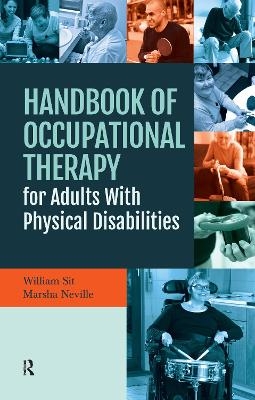
Handbook of Occupational Therapy for Adults with Physical Disabilities
SLACK Incorporated (Verlag)
978-1-63091-442-4 (ISBN)
This handbook is primarily organized by body system into six sections:
Occupational performance as a whole
Central nervous system
Peripheral nervous system, cranial nerves, and sensory system
Musculoskeletal system
Cardiovascular, lymphatic, respiratory, and integumentary systems
Endocrine, digestive, urinary, and reproductive system
At the beginning of each section, you will find a case study based on clinical experience that embodies the chapter subject. Within each section information is broken down into important aspects of the evaluation process, and then followed by the implications of each system on occupational therapy intervention. Handbook of Occupational Therapy for Adults With Physical Disabilities also includes a summary chart where readers can quickly and easily find the purpose, context, form, cost, and contact information for each assessment.
Handbook of Occupational Therapy for Adults With Physical Disabilities is ideal for occupational therapy students, recent graduates, and practitioners who are newly entering an adult physical disability practice setting.
About the Authors William Sit, PhD, OTR/L, BCPR, CLVST-BIG is a faculty member at Texas Woman’s University and chair of the Trinity North District of the Texas Occupational Therapy Association. For decades, he has worked in physical disabilities settings, including acute care, rehabilitation, outpatient, and home health, and he was unsatisfied with the availability of a single resource that effectively identifies key components of evaluation and intervention. As a result, he became motivated to write a handbook that fosters clinical reasoning development for occupational therapists in an adult practice setting, particularly for entry-level therapists and those newly entering a physical disabilities setting. Dr. Marsha Neville, OT, PhD began her career in occupational therapy in 1974 as a certified occupational therapy assistant. In 1978 she became a registered occupational therapist after graduating from Eastern Michigan University (Ypsilanti, Michigan). She later completed her PhD in Cognitive Neuroscience at the University of Texas at Dallas. Her long career in occupational therapy has focused on adult rehabilitation and research related to interventions for persons with acquired brain injuries. She is a professor in the School of Occupational Therapy at Texas Woman’s University.
CONTENTS Dedication v Acknowledgments xiii About the Authors xv Introduction xvii Section One: Occupational Performance. 1Unit 1: Need To Know Case 3 Chart Review 4 Client Interview 6 Continuum of Care 15 Documentation 16 Transfer Checklist. 22 Unit 2: Evaluation Common Assessments Across Practice Settings 25 Functional Outcome Measures for Acute and Intensive Care Unit Settings 34 Canadian Occupational Performance Measure 38 Functional Independence Measure and Quality Measures for Inpatient Rehabilitation Facilities 44 Barthel Index 77 Executive Function Performance Test 81 Home Safety Assessments 83 Driving and Community Mobility Screening 87 Unit 3: Intervention Common Interventions Across Practice Settings 91 Commonly Used Medical and Adaptive Equipment. 94 Easily Created Adaptive Equipment 96 Home Modifications 98 Ergonomic Modifications. 100 Job Accommodations 103 Driving Rehabilitation and Community Mobility 104 Section Two: Central Nervous System 111Unit 1: Need To Know Case 113 Structures, Functions, and Pathologies: Skills and Factors Associated With Areas of the Brain 114 FAST Warning Signs of a Stroke 129 Neuroendocrine Dysfunction Following Brain Injury 130 Unit 2: Evaluation Common Assessments Across Practice Settings 131 Glasgow Coma Scale 139 Rancho Los Amigos Level of Cognitive Functioning Scale 141 National Institutes of Health Stroke Scale 146 Allen Cognitive Levels. 151 Montreal Cognitive Assessment 162 Global Deterioration Scale 171 American Spinal Injury Association Impairment Scale 173 Modified Ashworth Scale. 179 Fugl-Meyer Assessment of Motor Recovery Following a Stroke 181 Unit 3: Intervention Common Interventions Across Practice Settings 183 Pain Management Strategies 184 Bed Positioning With Hemiplegia 186 Motor Control/Motor Learning 188 Cognitive Rehabilitation Strategies 190 Allen Cognitive Level Guidelines 194 Altered Mental Status and Dementia Intervention Strategies. 196 Functions Associated With Spinal Cord Injury Levels and Preserving Upper Extremity Function After a Spinal Cord Injury 199 Splinting for Spinal Cord Injuries 207 Central Nervous System Precautions and Contraindications 210 Section Three: Sensory System, Cranial Nerves, and Peripheral Nervous System 221Unit 1: Need To Know Case 223 Dizziness 224 Pupil Scale 229 Pain 230 Dermatomes and Key Test Points 232 Unit 2: Evaluation Common Assessments Across Practice Settings 234 Cranial Nerve Screening 237 Vestibular Evaluation 246 Vision Screening and Assessments 250 Pain Evaluation 253 Sensory Tests 254 Provocative Peripheral Nerve Tests 257 Unit 3: Intervention Common Interventions Across Practice Settings 265 Low Vision Intervention Strategies 268 Vestibular Rehabilitation. 271 Pain Management 274 Common Splints for the Peripheral Nervous System. 275 Peripheral Nervous System Precautions and Contraindications 276 Section Four: Musculoskeletal System 283Unit 1: Need To Know Case 285 Myotomes 286 Muscle Functions 287 Unit 2: Evaluation Common Assessments Across Practice Settings 296 Range of Motion 300 Manual Muscle Testing Guidelines 303 Dexterity and Coordination Assessments 311 Provocative Tests 313 Unit 3: Intervention Common Interventions Across Practice Settings 322 Inhibition and Facilitation Techniques 325 Physical Agent Modalities 329 Kinesio Taping 339 Orthopedic Serial Casting 343 Orthotic Guidelines 346 Prostheses 357 Wheelchair Prescription 362 Musculoskeletal System Precautions and Contraindications. 364 Section Five: Cardiovascular, Lymphatic, Respiratory, and Integumentary Systems 371Unit 1: Need To Know Case 373 Vital Signs 374 Hematology Values 377 Electrocardiogram Interpretation 379 Echocardiogram 383 Metabolic Equivalents and Activities 384 Unit 2: Evaluation Common Assessments Across Practice Settings 386 Stages of a Pressure Ulcer Wound 388 Edema Scale 390 Unit 3: Intervention Common Interventions Across Practice Settings 391 Phase 1 Cardiac Rehabilitation Guidelines and Precautions 394 Energy Conservation Tips 396 Burn Care 397 Passy-Muir Valve 401 Common Intensive Care Unit Equipment 402 Cardiovascular, Lymphatic, Respiratory, and Integumentary Systems Precautions and Contraindications 424 Section Six: Endocrine, Digestive, Urinary, and Reproductive Systems 429Unit 1: Need To Know Case 431 Chemistry Lab Values 432 Swallow Anatomy and Dysphagia 437 Unit 2: Evaluation Common Assessments Across Practice Settings 440 Pharmacology 442 Swallow Assessment 448 Unit 3: Intervention Common Interventions Across Practice Settings 450 Nutrition and Feeding Tubes 452 Dysphagia Management 454 Managing Ostomies 459 Managing Incontinence. 461 Addressing Sexuality 462 Endocrine, Digestive, Urinary, and Reproductive Systems Precautions and Contraindications 463 Appendix A: Conversions 467 Appendix B: Rehabilitation Abbreviations 469 Appendix C: Resources 479 Index 483
| Erscheinungsdatum | 03.07.2019 |
|---|---|
| Verlagsort | Thorofare |
| Sprache | englisch |
| Maße | 138 x 216 mm |
| Gewicht | 739 g |
| Themenwelt | Medizin / Pharmazie ► Physiotherapie / Ergotherapie ► Ergotherapie |
| ISBN-10 | 1-63091-442-8 / 1630914428 |
| ISBN-13 | 978-1-63091-442-4 / 9781630914424 |
| Zustand | Neuware |
| Haben Sie eine Frage zum Produkt? |
aus dem Bereich


